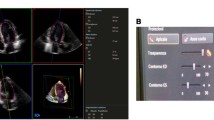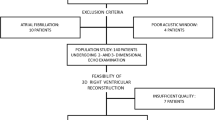Abstract
Background: Quantitative Three-dimensional echocardiography (3DEcho) of left ventricle (LV) is still limited because of the need for manually tracing endocardial borders: this can increase observer variability depending on the quality of fundamental (FUND) 2D images. We tested the combination of a simplified 3DEcho technique for LV reconstruction with automated endocardial border detection (Digital Echo Quantification, DEQ) and tissue harmonic imaging (THI) for enhancement of endocardium-cavity interface. Methods: Twenty-five consecutive patients with ischaemic heart disease and dilated or distorted LV underwent 3DEcho and gated-SPECT nuclear examinations evaluating:(a) end-diastolic and end-systolic volumes (EDV, ESV); (b) ejection fraction (EF); (c) volume/time curve (VTC). Thereafter, 3DEcho was applied to 47 patients with acute myocardial infarction (AMI) at pre-discharge and 6 months to evaluate remodelling. Results: Integrated 3DEcho values in THI modality were obtained in 84% of patients and correlated well with nuclear data for EDV (r= 0.95, mean difference =−2.2 ± 15.8 ml), ESV (r= 0.98, mean difference =−3.5 ± 10.2 ml), and EF (r= 0.82, mean difference = 0.6 ± 6.4%; all mean differences NS vs. 0), with an interobserver variability of 4.9, 5.7 and 8.2% for EDV, ESV and EF respectively. Automated VTC by 3DEcho in THI modality reproduced well that obtained by nuclear technique (r= 0.96) and allowed recognition of LV remodelling in 36% of patients at 6 months. Integrated 3DEcho values in FUND modality were obtained only in 52% of patients and showed much higher errors and interobserver variability. Conclusions: THI permits accurate 3D reconstruction of LV borders detected by DEQ, allowing automated VTC throughout the cardiac cycle as well as study of LV remodelling.
Similar content being viewed by others
References
Maehle J, Bjoernstad K, Aakhus S, Torp HG, Angelsen BAJ. Three-dimensional echocardiography for quantitative left ventricular wall motion analysis: a method for reconstruction of endocardial surface and evaluation of regional dysfunction. Echocardiography 1994; 11: 397–408.
Aakhus S, Maehle J, Bjoernstad K. A new method for echocardiographic computerized three-dimensional reconstruction of left ventricular endocardial surface: in vitro accuracy and clinical repeatability of volumes. J Am Soc Echocardiogr 1994; 7: 571–581.
Bjornstad K, Maehle J, Aakhus S, Torp HG, Hatle LK, Angelsen BA. Evaluation of references systems for quantitative wall motion analysis from three-dimensional endocardial surface reconstruction: an echocardiographic study in subjects with and without myocardial infarction. Am J Card Imaging 1996; 10: 244–253.
Iwase M, Kondo T, Hasegawa K, et al. Three-dimensional echocardiography by semi-automatic border detection in assessment of left ventricular volume and ejection fraction: comparison with magnetic resonance imaging. J Cardiol 1997; 30: 97–105.
Mele D, Mæhle J, Pedini I, Alboni P, Levine RA. Three-dimensional echocardiographic reconstruction: description and applications of a simplified technique for quantitative assessment of left ventricular size and function. Am J Cardiol 1998; 81: 107G–110G.
Mele D, Fehske W, Mæhle J, et al. A simplified, practical approach for three-dimensional surfacing and quantitation of the left ventricle: clinical application in patients with abnormally shaped hearts. J Am Soc Echocardiogr 1998; 11: 1001–1012.
Mele D, Campana M, Sclavo M, et al. Impact of tissue harmonic imaging in patients with distorted left ventricles: improvement in accuracy and reproducibility of visual, manual and automated echocardiographic assessment of left ventricular ejection fraction. Eur J Echocardiography 2003; 4: 59–67.
Chen CH, Nevo E, Fetics B, et al. Comparison of continuous left ventricular volumes by transthoracic two dimensional digital echo quantification with simultaneous conductance catheter measurements in patients with cardiac diseases. Am J Cardiol 1997; 80: 756–761.
Vanderberg BF, Rath LS, Stuhlmuller P, Melton HE, Skorton DJ. Estimation of left ventricular cavity area with on-line, semiautomated echocardiographic edge detection system. Circulation 1992; 86: 159–166.
Schnittger I, Fitzgerald PG, Daughters GT, et al. Limitations of comparing left ventricular volumes by two-dimensional echocardiography, myocardial markers and cineangiography. Am J Cardiol 1982; 50: 512–519.
Gordon EP, Schnittger I, Fitzgerald PJ, Williams P, Popp RL. Reproducibility of left ventricular volumes by two-dimensional echocardiography. J Am Coll Cardiol 1983; 2: 506–513.
Gorcsan J III, Lazar JM, Schulman DS, Follansbee WP. Comparison of left ventricular function by echocardiographic automated border detection and by radionuclide ejection fraction. Am J Cardiol 1993; 72: 810–815.
Henry WL, DeMaria A, Gramiak R. Report of the American Society of Echocardiography Committee on Nomenclature and Standards in two-dimensional echocardiography. Circulation 1980; 62: 212–217.
Henry WL, DeMaria A, Feigenbaum H, et al. Identification of myocardial wall segments. Report of the The American Society of Echocardiography Committee in Nomenclature and Standards. November 1982.
Nosir YFM, Vletter WB, Boersma E, et al. The apical long-axis rather than the two-chamber view should be used in combination with the four-chamber view for accurate assessment of left ventricular volumes and function. Eur Heart J 1997; 18: 1175–1185.
Germano G, Kiat H, Kavanagh PB, et al. Automatic quantification of ejection fraction from gated myocardial perfusion SPECT. J Nucl Med 1995; 36: 2138–2147.
Everaert H, Franken P, Flamen P, Momen A, Bossuyt A. Left ventricular volumes and ejection fraction from gated SPECT myocardial perfusion studies (abstr). J Nucl Cardiol 1997; 4: S102.
Bland JM, Altman DG. Statistical methods for assessing agreement between two methods of clinical measurement. Lancet 1986; 1: 307–310.
Buck T, Hunold P, Wentz KU, Tkalec W, Nesser HJ, Erbel R. Tomographic three dimensional echocardiographic determination of chamber size and systolic function in patients with left ventricular aneurysm: comparison to magnetic resonance imaging, cineventriculography, and two-dimensional echocardiography. Circulation 1997; 96: 4286–4297.
Altmann K, Shen Z, Boxt LM, et al. Comparison of three-dimensional echocardiographic assessment of volume, mass, and function in children with functionally single left ventricle with two-dimensional echocardiography and magnetic resonance imaging. Am J Cardiol 1997; 80: 1060–1065.
Nosir YF, Stocker J, Kasprzak JD, et al. Paraplane analysis from precordial three-dimensional echocardiography data sets for rapid and accurate quantification of left ventricular volume and function: a comparison with magnetic resonance imaging. Am Heart J 1999; 137: 134–143.
Kim WY, Sogaard P, Kristensen BO, Egeblad H. Measurement of left ventricular volumes by 3-dimensional echocardiography with tissue harmonic imaging: a comparison with magnetic resonance imaging. J Am Soc Echocardiogr 2001; 14: 169–179.
Mannaerts HF, Van Der Heide JA, Kamp O, et al. Quantification of left ventricular volumes and ejection fraction using freehand transthoracic three-dimensional echocardiography: comparison with magnetic resonance imaging. J Am Soc Echocardiogr 2003; 16: 101–109.
Kawai J, Tanabe K, Morioka S, Shiotani H. Rapid free-hand scanning three-dimensional echocardiography: accurate measurement of left ventricular volumes and ejection fraction compared with quantitative gated scintigraphy. J Am Soc Echocardiogr 2003; 16: 110–115.
Giannuzzi P, Temporelli PL, Bosimini E, et al. Heterogeneity of left ventricular remodeling after acute myocardial infarction: results of the Gruppo Italiano per lo Studio della Sopravvivenza nell’Infarto miocardico-3 (GISSI-3) echo substudy. Am Heart J 2001; 141: 131–138.
Urheim S, Bjornerheim R, Endresen K, et al. Quantification of left ventricular diastolic pressure-volume relations during routine cardiac catheterization by two-dimensional digital echo quantification and left ventricular micromanometer. J Am Soc Echocardiogr 2002; 15: 225–232.
Thomas JD, Rubin DN. Tissue harmonic imaging: why does it work? J Am Soc Echocardiogr 1998; 11: 803–808.
Zeidan Z, Erbel R, Barkhausen J, Hunold P, Bartel T, Buck T. Analysis of global systolic and diastolic left ventricular performance using volume-time curves by real-time three-dimensional echocardiography. J Am Soc Echocardiogr 2003; 16: 29–37.
Hozumi T, Yoshida K, Yoshioka H, et al. Echocardiographic estimation of left ventricular cavity area with a newly developed automated contour tracking method. J Am Soc Echocardiogr 1997; 10: 822–829.
Chandra S, Garcia MJ, Morehead A, Thomas JD. Two-dimensional Fourier filtration of acoustic quantification echocardiographic images. Improved reproducibility and accuracy of automated measurements of left ventricular performance. J Am Soc Echocardiogr 1997; 10: 310–319.
Mikic I, Krucinski S, Thomas JD. Segmentation and tracking in echocardiographic sequences: active contours guided by optical flow estimates. IEEE Trans Med Imaging 1998; 17: 274–284.
Bosch JG, Mitchell SC, Lelieveldt BP, et al. Automatic segmentation of echocardiographic sequences by active appearance motion models. IEEE Trans Med Imaging 2002; 21: 1374–1383.
Sugioka K, Hozumi T, Watanabe H, et al. Rapid and accurate noninvasive assessment of global left ventricular systolic function using biplane advanced automated contour tracking method. J Am Soc Echocardiography 2003; 16: 1237–1243.
Sugioka K, Hozumi T, Yagi T, et al. Automated quantification of left ventricular function by the automated contour tracking method. Echocardiography 2003; 20: 313–318.
Wong SP, Johnson RK, Sheehan FH. Rapid and accurate left ventricular surface generation from three-dimensional echocardiography by a catalog based method. Rapid LV surface generation by three-dimensional echo. Int J Cardiovasc imaging 2003; 19: 19–21.
Author information
Authors and Affiliations
Rights and permissions
About this article
Cite this article
Mele, D., Teoli, R., Cittanti, C. et al. Assessment of left ventricular volume and function by integration of simplified 3D echocardiography, tissue harmonic imaging and automated extraction of endocardial borders. Int J Cardiovasc Imaging 20, 191–202 (2004). https://doi.org/10.1023/B:CAIM.0000021948.96454.3a
Issue Date:
DOI: https://doi.org/10.1023/B:CAIM.0000021948.96454.3a




